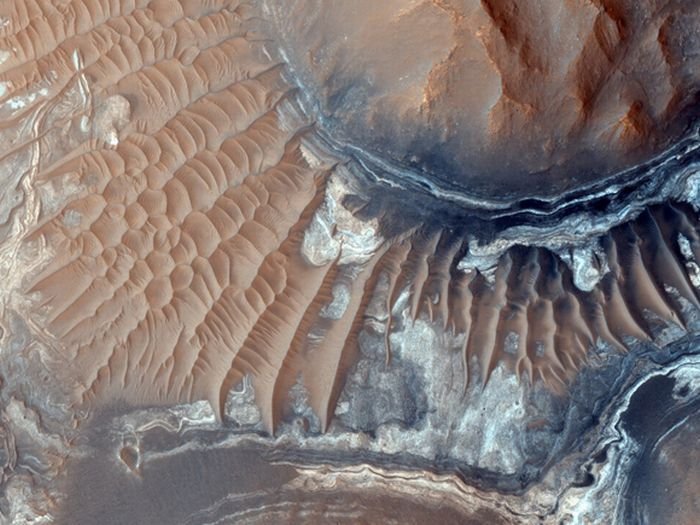|
|
Mars Surface
|
Based on orbital observations and the examination of the Martian meteorite collection, the surface of Mars appears to be composed primarily of basalt. Some evidence suggests that a portion of the Martian surface is more silica-rich than typical basalt, and may be similar to andesitic rocks on Earth; however, these observations may also be explained by silica glass. Much of the surface is deeply covered by finely grained iron(III) oxide dust.
Although Mars has no evidence of a current structured global magnetic field, observations show that parts of the planet's crust have been magnetized, and that alternating polarity reversals of its dipole field have occurred in the past. This paleomagnetism of magnetically susceptible minerals has properties that are very similar to the alternating bands found on the ocean floors of Earth. One theory, published in 1999 and re-examined in October 2005 (with the help of the Mars Global Surveyor), is that these bands demonstrate plate tectonics on Mars four billion years ago, before the planetary dynamo ceased to function and caused the planet's magnetic field to fade away.
Current models of the planet's interior imply a core region about 1,480 km in radius, consisting primarily of iron with about 14–17% sulfur. This iron sulfide core is partially fluid, and has twice the concentration of the lighter elements than exist at Earth's core. The core is surrounded by a silicate mantle that formed many of the tectonic and volcanic features on the planet, but now appears to be inactive. The average thickness of the planet's crust is about 50 km, with a maximum thickness of 125 km. Earth's crust, averaging 40 km, is only one third as thick as Mars’ crust, relative to the sizes of the two planets.
During the Solar system formation, Mars was created out of the protoplanetary disk that orbited the Sun as the result of a stochastic process of run-away accretion. Mars has many distinctive chemical features caused by its position in the Solar System. Elements with comparatively low boiling points such as chlorine, phosphorus and sulphur are much more common on Mars than Earth; these elements were probably removed from areas closer to the Sun by the young Sun's powerful solar wind.
|
|









